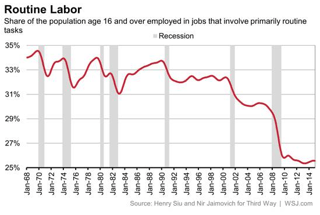
A quick look at the numbers suggests overall job growth and lower unemployment since 2008’s recession. But taking a closer look, the jobs that did increase were either low-paying/low-skill OR required a college degree which is increasingly difficult to afford.
So, what do we know about the kinds of jobs the economy is struggling to keep? We know more “routine” jobs are being lost to increasingly complex technology and industry, and that more “non-routine” jobs are the ones that are actually on the rise.
Since it’s hard for me to talk about pretty much anything in life without referring it back to CLASS, it got me thinking: How does all this talk about “routine” and “non-routine” in the workforce relate to CLASS??
Two words: Instructional. Support.
The Instructional Support dimensions (Concept Development, Quality Feedback, Language Modeling) address precisely the kinds of skills our students need to be competitive in tomorrow’s workforce. For instance:
- the ability to problem-solve alone and with others,
- communicate effectively,
- give and receive useful feedback,
- adapt to changing needs and resources, and
- think creatively.
The problem (for many reasons beyond this humble post) is that it's precisely these skills that are hard for teachers to help students develop. Teachers are pressured to prioritize rote and routine cognitive tasks over practices that challenge students to think, compare, contrast, brainstorm, and reflect. Scores in these dimensions— across demographics, geography, age levels and over time—are universally low and are difficult to change.
Luckily, there is a bright light shining at the end of the tunnel: CLASS Professional Development (PD)!
Research shows that important ingredients for solid PD support systems in education are things like: how aligned and targeted are efforts, and how focused, intensive, or comprehensive are they over time? When all of this comes together good things happen for students and teachers.
It’s so exciting to learn about the many ways people are embedding CLASS into their high quality and intentional PD efforts. According to our State of CLASS survey conducted earlier this year, over 79% of respondents work to link CLASS with their efforts to support teacher growth and development. That’s awesome, but of course, ideally we’d see this at 100% in the future.
The more that educators agree to prioritize and promote teaching practices that align with CLASS, the more teachers that will be able to foster Instructional Support interactions that today’s students will need for their futures.
And that, if anything, should be something we can all agree on!
What are your experiences embedding CLASS into your professional support system? We’d love to hear your thoughts on what has worked well and what is still tough!


